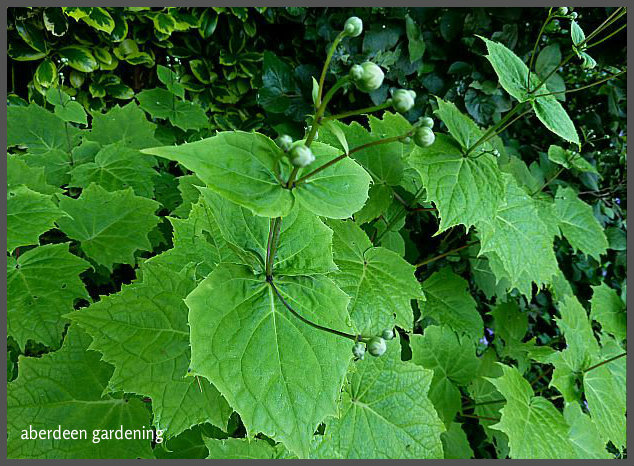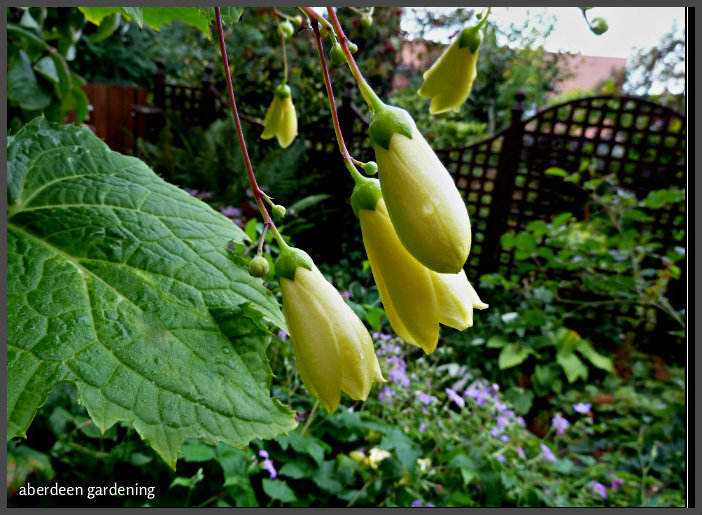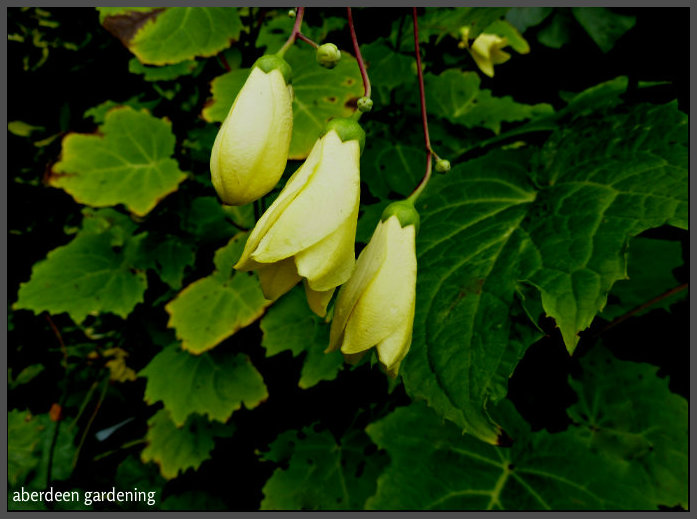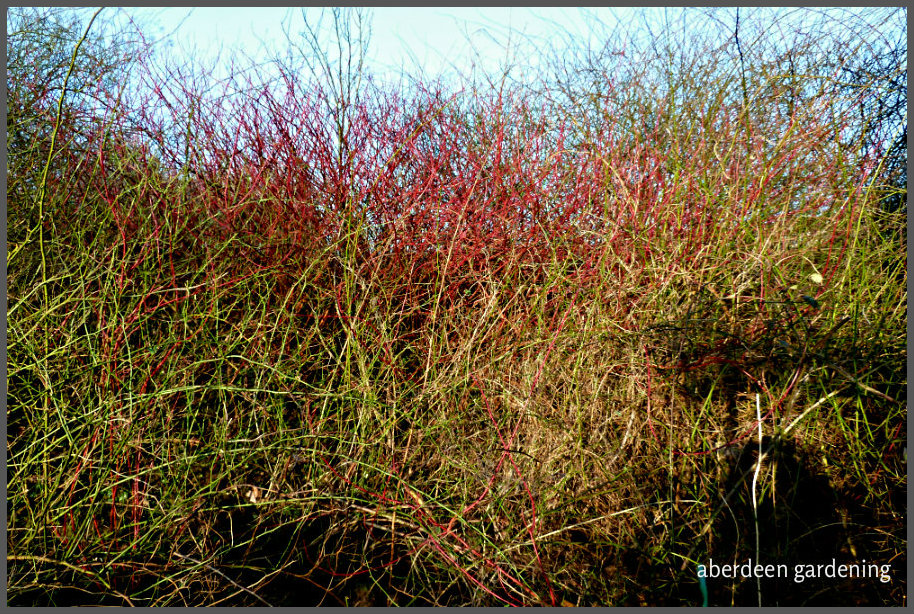Kirengeshoma palmata yellow waxbells
Kirengeshoma palmata, also known as yellow waxbells is a rather unusual woodland plant.
I featured it way back in 2006, a time when I was not too sure where I was going with my blog, in fact, I was totally groping in the dark and did not do this amazing plant the justice it deserves.
Time for a revisit.
*** Kirengeshoma in our garden ***
This unusual, and not that common perennial was moved from pillar to post in our garden over the years.
It proved to perform best of all in a position that did not receive full sun for most of the day, in fact in a south facing spot it was quite dismal.
Eventually, Kirengeshoma found its permanent home in our woodland area.
Blooming in September, some years it was spectacular, in others the biting winds and unseasonable cold weather in Aberdeen caused a fair bit of damage to the plant.
However, more often than not, it gave a good show, and was another of those perennials, that made me look forward to seeing the young shoots push through the soil in early May. Being so late in coming through the soil, I would at times think the Winter had put an end to it.
We all have different experiences with garden plants, personally I would rate this one nine out of ten, and probably would have given it a ten if it weren’t for the damage caused by the harsher weather conditions in the far north of the country.
*** plant description ***
The Japanese herbaceous plant Kirengeshoma palmata generally grows to a height of between 90cm/3ft – 120cm/4ft. The dark bronzy/purple slim stems are robust, yet slightly arching, support is usually not required.
Take care not to tread on the emerging shoots in late Spring, when most other herbaceous plants are well through.
The mid green leaves are quite large and Sycamore shaped. In late Summer, the flower buds will be visible on slender stems, it will likely be early Autumn before they open.
Those tubular bell shaped, waxy, creamy yellow flowers are well worth waiting until September for, each one about an inch long.
The irony is, although Kirengeshoma prefers a cool shady spot, its also prone to flower damage from early frost.
Being a woodlander, soil on the acidic side is essential.
Your plant may take a few years to clump up, when you feel its large enough to divide, lift it in Spring when the shoots have come through.
Kirengeshoma requires the soil to be moist but free draining, take care it doesn’t dry out in Summer and feed only very lightly.
*** Hardiness *** fully hardy, any suggestion to tenderness is in regard to flower damage from frost.
*** Position *** woodland/partial shade.
*** Soil *** loamy,deep acidic soil
____________
The Woodpecker is now a regular visitor, seldom stays long enough to get a shot.
_____________
At last a little sunshine, lighting up the dogwood in the woodland area.
____________
This is our woodland path, facing North, its long and straight and rather waterlogged after a few miserable wet days.
There is room for some wood land plants at either side of the path.
We are thinking of putting in some Clematis and Honeysuckle to scramble over the lower canopy, and also plant some English bluebells and Daffs.
I will keep updating on the progress.
___________
The South facing side is not quite so wet. The Clematis Montana which requires little pruning arrived this morning, should be ideal and also the native Honeysuckle (Heaven scent) also arrived. Think I will also order some native Daffodils and Bluebells available in the green.
*** Honeysuckle Heaven scent – Buy now ***
*** Clematis Montana – Buy now ***
*** English bluebells – Buy now ***
If you happen to leave a comment I will be sure to visit your site and do the same










There’s a lovely big Kirengoshoma at Ness in a woodland setting, if you are at this end of Cheshire. I got one from Derwen Nurseries near Welshpool a few years ago, a great plant for a shadier spot.
Thanks Sunil, I will keep working on it.
Hello Alistair, keep it coming with the woodland plant suggestions! This is another one for me to add to the list, I’ve never heard of Yellow Waxbells before, but there are several places in the garden it might find a good home in. I look forward to your planting up of the woodland path areas with Montana, Honeysuckle and spring bulbs, it should look fantastic when established!
Good luck with your Kirengeshoma Alain.
Hi Alistair,
Thank you for visiting my blog.
I got Kirengeshoma seeds this winter and plan to seed them later on. If I manage to get some to grow, I will have to prepare a special spot for them in the garden as the soil is alkaline. Making a fair size hole and filling it with compost should do it.
Looking for what I think will be the best spot in our woodland to plant one Donna
Rick, I also have seen a lot of leaf damage, always put it down to slugs.
I intend proving its a woodland in my next post Alberto. Not every expert is convinced that Kirengeshoma belongs to the Hydrangea family.
The Kirangeshoma is an unusual plant Indie and like yourself I love to get visits from the woodpecker.
I love visiting your blog, Alistair, because you always feature plants I’ve never seen before. What a gorgeous woodland plant! I like the leaves on it, too. What a striking woodpecker you have! Beautiful bird! Woodpeckers are my favorites 🙂
Well that looks to me like a piece of woodland! It’s the feeling that matters, isn’t it? I love those yellow waxbells, I think I’ve seen them at the Amsterdam Arboretum, those maple-like leaves really impressed me but the thing that impressed me even more is that this plant is from the hydrangea family, it’s surprising, isn’t it?
Hi Alistair, I grow Kirengeshoma at the base of a silver birch where, once it was established, it has done well. Like your experiences in Aberdeen in an early winter it does not get to flower although this is rare, the other problem is that in some years the lower foliage gets very badly eaten, although this does not look like typical slug damage I have never found anything on it so have had to put it down to slugs in the end.
I do like the large leaves, they add nice shade-garden texture. They hold their own with all the other large-leaf shade plants.
Definitely a plant worth trying Pam. I intend making something of the woodland walk and at sometime I will show that further down on the South side of the walk it leads to a true woodland area with a river running through it.
I’ve coveted waxbells for ages and still don’t have one. It is prized by knowledgeable gardeners here, because it is one of the most interesting and dramatic plants for shade. I am redoing the Woodland Walk this year and intend to buy one if I can find it. Your woodland path will look great with English bluebells, a favorite of mine. P. x
I know what you mean Deb but for some, online mail order is pretty essential. There are some which are excellent, in the UK Waitrose garden have excellent quality plants (http://www.awin1.com/awclick.php?mid=6245&id=227509 – Waitrose)
Hi Greggo, what!!! my precious Cheshire woodland, (a thicket) I think not!! Hmph, just you wait (lol) did I really say lol, omg.
Good to see your comment, Al. Looks a tad bit mushy to me in the walkway I’d say and it looks more like a thicket than a woodland.
Looked back at your Aberdeen review from last year, wow! you must miss that garden. Later gator!
Hello, Alistair! Kirengoshoma has been on my list for a while. The leaves are impressive, and the flowers are a wonderful bonus. I have the perfect place in my woodland garden for one, if only I could find one to buy. I prefer local sources, but sometimes I end up ordering from the internet, which is not always a successful experience.
Hello Carolyn, Carol Klein says Koreana is a bigger plant with flowers not quite as graceful as Palmata, and these plants were once listed as belonging to the Saxifragaceae family but now it has been decided they belong to the genus Hydrangeaceae. She also suggests she has doubts as to whether either is correct.
Kirengoshoma is an underrated and underused shade plane. You have highlighted all its good qualities. Even before it blooms it has a commanding presence in the garden like a medium-sized shrub. I can’t figure out how K. palmata and K. koreana differ and think they are confused in the trade.
Thank you Donna,cheered me up on a grey miserable day.
Alistair this is quite a plant. We have a smaller delicate Uvularia perfoliata which has yellow bell-like flowers. I adore your woodland path and your plans of the bluebells and daffs…and of course the vines. I look forward to seeing the walkway and all your gardens as they develop….you continue to inspire me!
The woodland walkway is a mess at the moment Angie, determined to make some improvement. Glad to be of help with the Kirengeshoma.
You’ve answered a few questions I had about this plant Alistair. Mine struggles a bit and I suspected it was in a spot that got too windy. It’s still young and not making much of a specimen but you’ve confirmed that this will take time.
Useful post. Like the wee walkway, it would look pretty with the spring bulbs you’ve got planned.